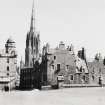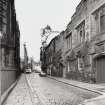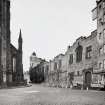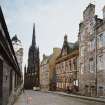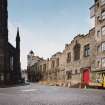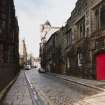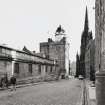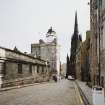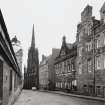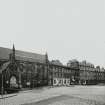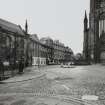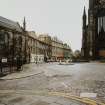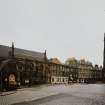Edinburgh, 549 Castlehill, Outlook Tower
Camera Obscura (19th Century), Observatory (19th Century), Tenement (17th Century), Visitor Centre (20th Century)
Site Name Edinburgh, 549 Castlehill, Outlook Tower
Classification Camera Obscura (19th Century), Observatory (19th Century), Tenement (17th Century), Visitor Centre (20th Century)
Alternative Name(s) Geddes's Camera Obscura; Short's Observatory
Canmore ID 52343
Site Number NT27SE 316
NGR NT 25435 73528
Datum OSGB36 - NGR
Permalink http://canmore.org.uk/site/52343
- Council Edinburgh, City Of
- Parish Edinburgh (Edinburgh, City Of)
- Former Region Lothian
- Former District City Of Edinburgh
- Former County Midlothian
NT27SE 316 25430 73529
The four harled lower floors survive from two 17th century tenements. Raised in a reconstruction in 1853 as Short's Observatory (probably by David Rhind). Minor alteration in 1895, 1896, and recently. W door, probably of 1686, brought from Woolmet House, Midlothian in 1955.
RCAHMS 1951; J Gifford, C McWilliam and D Walker 1984.
Publication Account (1951)
No. 9 Outlook Tower, 549 Castle Hill
The four rubble-built lower storeys of this tenement, standing on the N side of the Castle Hill immediately opposite Boswell’s Court (RCAHMS 1952, No. 11 [NT27SE 317]) date from the 17th century, while the upper part has been rebuilt and extended. The ground floor includes a through passage, Skinner’s Close, and still shows something of the original arrangements with some 18th century alteration, but it is now used only for storage. The floors above have been entirely remodelled and modernised.
Thomas Hamilton, the architect of the High Street, included this building in his record of the W end of the Old Town and his drawing (Old Edin. Club, xii, p.249) shows the façade before alteration. This drawing indicates that the present frontage was originally occupied by two tenements, the E one having at the SE corner a staircase, part of which still survives.
RCAHMS 1951
Project (1997)
The Public Monuments and Sculpture Association (http://www.pmsa.org.uk/) set up a National Recording Project in 1997 with the aim of making a survey of public monuments and sculpture in Britain ranging from medieval monuments to the most contemporary works. Information from the Edinburgh project was added to the RCAHMS database in October 2010 and again in 2012.
The PMSA (Public Monuments and Sculpture Association) Edinburgh Sculpture Project has been supported by Eastern Photocolour, Edinburgh College of Art, the Edinburgh World Heritage Trust, Historic Scotland, the Hope Scott Trust, The Old Edinburgh Club, the Pilgrim Trust, the RCAHMS, and the Scottish Archive Network.
Field Visit (20 August 2002)
Coat of arms of the Biggars, carved in high relief, in a broken bell-shaped pediment above entrance to Camera Obscura. The shield is decorated with a blue bend (diagonal stripe) between two red mullets (stars), and is surrounded by white foliage. A helmet with a closed visor is above the shield. The crest is a pelican's head and neck, the pelican vulning her breast (wounding so that the blood appears dropping). Motto on gilded-edged cartouche below.
The whole door, including the coat of arms, was originally part of Woolnet House in Midlothian, built 1686. The house was demolished in 1953 and the door moved to the Camera Obscura in 1955.
According to Gifford et al, the coat of arms is that of the Biggars of Woolnet (1).
Inspected By : D. King
Inscriptions : In cartouche below coat of arms (incised gilded letters): GIVING AND FORGIVING
Signatures : None Visible
Design period : c.1686
Year of unveiling : 1955
Information from Public Monuments and Sculpture Association (PMSA Work Ref : EDIN1010)







































